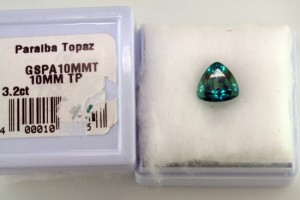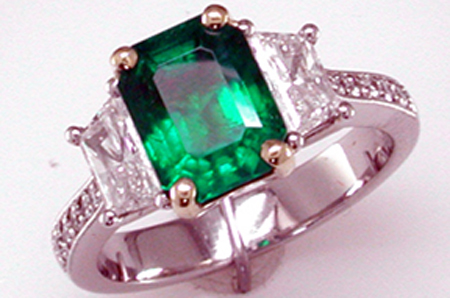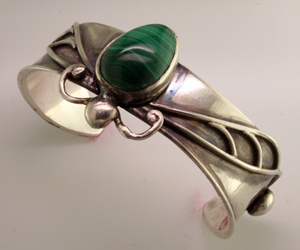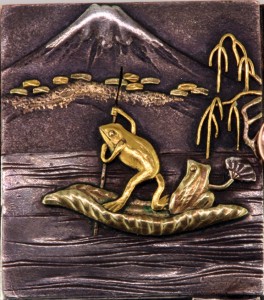
18K Ring with Natural and Chatham Emeralds
We just completed this challenging design to the delight of our client. Read the rest of the story, Custom Jewelry Takes a Slow Boat to China, on the Mardon Blog

Coated stone masquerading as "Paraiba"
Our industry has a real problem with proper disclosure and representation of gem materials. Mother Nature does not create finished gems, so we have always had to shape and polish gem materials to make them beautiful and suitable for jewelry. Along with the process of cutting and polishing, we’ve learned how to enhance these raw materials for color, clarity, and durability. The problem comes when sellers don’t educate their customers about these various enhancements or worse, when they use weasel words to imply that relatively common enhanced gem materials are rare and valuable. The current marketing of coated “Paraiba Topaz” can only damage the already battered image of the gem industry. For some good photos and a discussion of this issue, read our blog “Paraiba Topaz-No MIne Exists“

Medallion Celebrates a Championship
One of our local high school teams, the Riverside Polytechnic High women’s water polo team, won the championship for their division so the booster club decided to reward them with a special piece of jewelry. We used our JewelSmith CAD/CAM system to create these Argentium silver medallions on budget and on time! See the entire process on our Blog, “A Special Graduation Gift“

Matilija Flower Pendant
The Matilija Poppy is a beautiful and very recognizable wildflower found only in Southern California, making it a great subject for what I call “Local Product”. If you can find an object, a symbol, a graphic, or a phrase that is unique to your community, try using it as a design theme for a line of jewelry. We’ve had great success with jewelry collections featuring the Tennessee Pearl, the Riverside Raincross, and the Matilija Poppy. The key is to find something that resonates strongly within a community, and then develop your designs around it.
It’s not always easy–While living in Tennessee, we manufactured Tennessee Pearl jewelry that sold extremely well in the eastern part of the state. We would hardly sell a piece in West Tennessee–it was just a different mindset.
Look for things that your community is proud of, that identify your town or area, or that stand out as unusual. Our Raincross Collection has helped keep the doors open in these tough times. You could even try things like Bigfoot or Flying Saucers. Read how our Matilija Collection is connected to Southern California on the Mardon Blog.

Over the last 40 years or so, with intensifed gem prospecting planetwide, many new gems have come onto the scene. Because of it’s beauty and reputation, the emerald remains our most expensive green gem, but other new stones are equally beautiful and wearable and in some cases, more rare than emerald. Follow our discussion of the best of these beautiful alternatives,–do you know “Which one is the emerald”?
 May 12– Just as we predicted in our Blog, April 18, Sotheby’s achieved a record price of ~ 9.5 million US for the fabulous 7.03 ct Fancy Vivid Blue Internally Flawless Cullinan Blue Diamond. Sotheby’s original presale estimate was 5.8 to 8.5 million US.
May 12– Just as we predicted in our Blog, April 18, Sotheby’s achieved a record price of ~ 9.5 million US for the fabulous 7.03 ct Fancy Vivid Blue Internally Flawless Cullinan Blue Diamond. Sotheby’s original presale estimate was 5.8 to 8.5 million US.
The stone sets a record price per carat for any gemstone sold at auction of $1,349,752, Sotheby’s said.
This is great news for gem aficionados at all levels. As ongoing gem prospecting continues world wide and exciting gem finds deliver new and exotic gem materials to the market place, the opportunities to own fabulous collectible gems abound, especially for those who have big dollars to spend. Now is the time to buy! We welcome inquiries and discussion from all Orchidians and gem lovers.

2.54 ct Muzo emerald, before restoration
One of the skills we learn as gemologists is how to evaluate damage to gemstones. Most jewelers know that diamonds can be repaired or recut, but what about other gems, like this emerald? Emeralds are usually enhanced with oils or resins, complicating the process. Our Blog, Recutting Emeralds tells success stories of three different emeralds, all from different sources.

2.54 ct Muzo recut to 2.29 ct, magnificent once again

Moth Bracelet 1 1973
This bracelet is an example of what I call slow jewelry. Made from two sterling silver butter-knives, the design flowed from the the actual shape of the knife blades and the unusual malachite stone – it’s puffy shape and cross-grain cut reminded me of the body of a sphinx moth freshly emerged from the chrysallis. The bracelet was made flat, brazed together with a “Bernzomatic” propane can torch, then shaped around a bracelet mandrel.
For more jewelry examples and my philosophy of slow jewelry, read the Mardon Blog, The Slow Jewelry Manifesto. Comments and discussion are welcome.
 We struggled a bit to create this Mother’s ring, but our client was thrilled with the outcome. Communication was the key. Follow the progress of this custom order, start to finish, at the Mardon Blog
We struggled a bit to create this Mother’s ring, but our client was thrilled with the outcome. Communication was the key. Follow the progress of this custom order, start to finish, at the Mardon Blog

The Frog Boatman
This wonderful panel, one of nine in a hinged link bracelet and less than one inch high, shows the superb craftsmanship and artistic vision of an unknown Japanese metalworker. We think the piece might be Meiji period or a little later-we’ve only seen this quality of work on samurai objects. After the Meiji Restoration, since the samurai were out of a job and weren’t allowed to carry their traditional swords and accouterments, the artisans of the time turned their hand to other forms of metal work, including jewelry.
We welcome any additional information about the bracelet, the technique, or anything pertinent.
See the rest of the bracelet at the Mardon Blog, Museum Quality









 We struggled a bit to create this Mother’s ring, but our client was thrilled with the outcome. Communication was the key. Follow the progress of this custom order, start to finish, at the Mardon
We struggled a bit to create this Mother’s ring, but our client was thrilled with the outcome. Communication was the key. Follow the progress of this custom order, start to finish, at the Mardon 